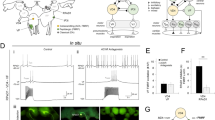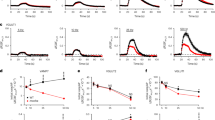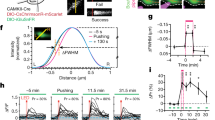Abstract
Despite the importance of neuropeptide release, which is evoked by long bouts of action potential activity and which regulates behavior, peptidergic vesicle movement has not been examined in living nerve terminals. Previous in vitro studies have found that secretory vesicle motion at many sites of release is constitutive: Ca2+ does not affect the movement of small synaptic vesicles in nerve terminals or the movement of large dense core vesicles in growth cones and endocrine cells. However, in vivo imaging of a neuropeptide, atrial natriuretic factor, tagged with green fluorescent protein in larval Drosophila melanogaster neuromuscular junctions shows that peptidergic vesicle behavior in nerve terminals is sensitive to activity-induced Ca2+ influx. Specifically, peptidergic vesicles are immobile in resting synaptic boutons but become mobile after seconds of stimulation. Vesicle movement is undirected, occurs without the use of axonal transport motors or F-actin, and aids in the depletion of undocked neuropeptide vesicles. Peptidergic vesicle mobilization and post-tetanic potentiation of neuropeptide release are sustained for minutes.
This is a preview of subscription content, access via your institution
Access options
Subscribe to this journal
Receive 12 print issues and online access
$209.00 per year
only $17.42 per issue
Buy this article
- Purchase on Springer Link
- Instant access to full article PDF
Prices may be subject to local taxes which are calculated during checkout








Similar content being viewed by others
References
Zupanc, G.K. Peptidergic transmission: from morphological correlates to functional implications. Micron. 27, 35–91 (1996).
Hokfelt, T., Broberger, C., Xu, Z.Q., Sergeyev, V., Ubink, R. & Diez, M. Neuropeptides—an overview. Neuropharmacology 39, 1337–1356 (2000).
Taghert, P.H. & Veenstra, J.A. Drosophila neuropeptide signaling. Adv. Genet. 49, 1–65 (2003).
Whim, M.D. & Lloyd, P.E. Frequency-dependent release of peptide cotransmitters from identified cholinergic motor neurons of Aplysia. Proc. Natl. Acad. Sci. USA 86, 9034–9038 (1989).
Martin, T.F. The molecular machinery for fast and slow neurosecretion. Curr. Opin. Neurobiol. 4, 626–632 (1994).
Holt, M., Cooke, A., Neef, A. & Lagnado, L. High mobility of vesicles supports continuous exocytosis at a ribbon synapse. Curr. Biol. 14, 173–183 (2004).
Rea, R. et al. Streamlined synaptic vesicle cycle in cone photoreceptor terminals. Neuron 41, 755–766 (2004).
Henkel, A.W., Simpson, L.L., Ridge, R.M. & Betz, W.J. Synaptic vesicle movements monitored by fluorescence recovery after photobleaching in nerve terminals stained with FM1-43. J. Neurosci. 16, 3960–3967 (1996).
Kraszewski, K., Daniell, L., Mundigl, O. & DeCamilli, P. Mobility of synaptic vesicles in nerve endings monitored by recovery from photobleaching of synaptic vesicle-associated fluorescence. J. Neurosci. 16, 5905–5913 (1996).
Ng, Y.K., Lu, X. & Levitan, E.S. Physical mobilization of secretory vesicles facilitates neuropeptide release by nerve growth factor-differentiated PC12 cells. J. Physiol. 542, 395–402 (2002).
Becherer, U., Moser, T., Stuhmer, W. & Oheim, M. Calcium regulates exocytosis at the level of single vesicles. Nat. Neurosci. 6, 846–853 (2003).
Zucker, R.S. & Regehr, W.G. Short-term synaptic plasticity. Annu. Rev. Physiol. 64, 355–405 (2002).
Seward, E.P., Chernevskaya, N.I. & Nowycky, M.C. Exocytosis in peptidergic nerve terminals exhibits two calcium-sensitive phases during pulsatile calcium entry. J. Neurosci. 15, 3390–3399 (1995).
Brezina, V., Church, P.J. & Weiss, K.R. Temporal pattern dependence of neuronal peptide transmitter release: models and experiments. J. Neurosci. 20, 6760–6772 (2000).
Ludwig, M. et al. Intracellular calcium stores regulate activity-dependent neuropeptide release from dendrites. Nature 418, 85–89 (2002).
Steyer, J.A., Horstmann, H. & Almers, W. Transport, docking and exocytosis of single secretory granules in live chromaffin cells. Nature 388, 474–478 (1997).
Olofsson, C.S. et al. Fast insulin secretion reflects exocytosis of docked granules in mouse pancreatic B-cells. Pflugers Arch. 444, 43–51 (2002).
Duncan, R.R. et al. Functional and spatial segregation of secretory vesicle pools according to vesicle age. Nature 422, 176–180 (2003).
Han, W., Ng, Y.K., Axelrod, D. & Levitan, E.S. Neuropeptide release by efficient recruitment of diffusing cytoplasmic secretory vesicles. Proc. Natl. Acad. Sci. USA 96, 14577–14582 (1999).
Ng, Y.K. et al. Unexpected mobility variation among individual secretory vesicles produces an apparent refractory neuropeptide pool. Biophys. J. 84, 4127–4134 (2003).
Burke, N.V. et al. Neuronal peptide release is limited by secretory granule mobility. Neuron 19, 1095–1102 (1997).
Levitan, E.S. Using GFP to image peptide hormone and neuropeptide release in vitro and in vivo. Methods 33, 281–286 (2004).
Rao, S., Lang, C., Levitan, E.S. & Deitcher, D.L. Visualization of neuropeptide expression, transport, and exocytosis in Drosophila melanogaster. J. Neurobiol. 49, 159–172 (2001).
Atwood, H.L., Govind, C.K. & Wu, C.F. Differential ultrastructure of synaptic terminals on ventral longitudinal abdominal muscles in Drosophila larvae. J. Neurobiol. 24, 1008–1024 (1993).
Jia, X.X., Gorczyca, M. & Budnik, V. Ultrastructure of neuromuscular junctions in Drosophila: comparison of wild type and mutants with increased excitability. J. Neurobiol. 24, 1025–1044 (1993).
Husain, Q.M. & Ewer, J. Use of targetable GFP-tagged neuropeptide for visualizing neuropeptide release following execution of a behavior. J. Neurobiol. 59, 181–191 (2004).
Heifetz, Y. & Wolfner, M.F. Mating, seminal fluid components, and sperm cause changes in vesicle release in the Drosophila female reproductive tract. Proc. Natl. Acad. Sci. USA 101, 6261–6266 (2004).
Jan, L.Y. & Jan, Y.N. Properties of the larval neuromuscular junction in Drosophila melanogaster. J. Physiol. 262, 189–214 (1976).
Stewart, B.A., Atwood, H.L., Renger, J.J., Wang, J. & Wu, C.F. Improved stability of Drosophila larval neuromuscular preparations in haemolymph-like physiological solutions. J. Comp. Physiol. A 175, 179–191 (1994).
Barclay, J.W., Atwood, H.L. & Robertson, R.M. Impairment of central pattern generation in Drosophila cysteine string protein mutants. J. Comp. Physiol A. 188, 71–78 (2002).
Cattaert, D. & Birman, S. Blockade of the central generator of locomotor rhythm by noncompetitive NMDA receptor antagonists in Drosophila larvae. J. Neurobiol. 48, 58–73 (2001).
Pfister, K.K., Wagner, M.C., Bloom, G.S. & Brady, S.T. Modification of the microtubule-binding and ATPase activities of kinesin by N-ethylmaleimide (NEM) suggests a role for sulfhydryls in fast axonal transport. Biochemistry 28, 9006–9012 (1989).
Phelps, K.K. & Walker, R.A. N-ethylmaleimide inhibits Ncd motor function by modification of a cysteine in the stalk domain. Biochemistry 38, 10750–10757 (1999).
Perry, S.V. & Cotterill, J. The action of thiol reagents on the adenosine-triphosphatase activities of heavy meromyosin and L-myosin. Biochem. J. 96, 224–230 (1965).
Delgado, R., Maureira, C., Oliva, C., Kidokoro, Y. & Labarca, P. Size of vesicle pools, rates of mobilization, and recycling at neuromuscular synapses of a Drosophila mutant, shibire. Neuron 28, 941–953 (2000).
Rizzoli, S.O. & Betz, W.J. The structural organization of the readily releasable pool of synaptic vesicles. Science 303, 2037–2039 (2004).
Bantignies, F., Goodman, R.H. & Smolik, S.M. Functional interaction between the coactivator Drosophila CREB-binding protein and ASH1, a member of the trithorax group of chromatin modifiers. Mol. Cell Biol. 20, 9317–9330 (2000).
Acknowledgements
This research was supported by US National Institutes of Health grant NS32385 (to E.S.L.) and Oklahoma Center for Science and Technology grant HR03-048S (to R.S.H.). We thank C. Ziegler for technical assistance.
Author information
Authors and Affiliations
Corresponding author
Ethics declarations
Competing interests
The authors declare no competing financial interests.
Rights and permissions
About this article
Cite this article
Shakiryanova, D., Tully, A., Hewes, R. et al. Activity-dependent liberation of synaptic neuropeptide vesicles. Nat Neurosci 8, 173–178 (2005). https://doi.org/10.1038/nn1377
Received:
Accepted:
Published:
Issue Date:
DOI: https://doi.org/10.1038/nn1377
This article is cited by
-
Temperature dependence of vesicular dynamics at excitatory synapses of rat hippocampus
Cognitive Neurodynamics (2014)
-
Dynamics of peptidergic secretory granule transport are regulated by neuronal stimulation
BMC Neuroscience (2010)
-
The essential role of bursicon during Drosophiladevelopment
BMC Developmental Biology (2010)
-
Homer and the ryanodine receptor
European Biophysics Journal (2009)
-
Presynaptic Ryanodine Receptor–CamKII Signaling is Required for Activity-dependent Capture of Transiting Vesicles
Journal of Molecular Neuroscience (2009)



